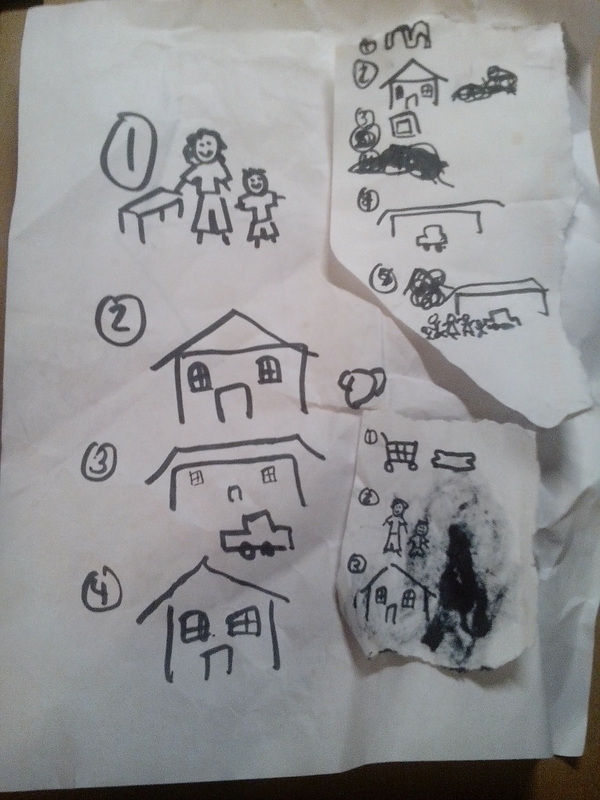What's the big deal with this? Well, to those of you who aren't aware, people on the autism spectrum frequently have trouble transitioning from one activity to another. This can be due to many factors, although need for predictability (change is scary!) and a warning about an impending shift in the sensory environment seem to be the biggest. Transition time can be accomplished by many means, but all of them work towards the same end - warning that a transition is upcoming.
The benefits:
Growing up, Caley says that transition time was really helpful for her (and our mother says it made her life easier, too!). Given their backing, I started implementing it with the children on the spectrum I care for and saw pretty immediate improvements in the behavior of the children I care for (a huge decrease in crying/screaming/upset incidents and an actual decrease in the time it took me to move us to the next activity) myself.
How to help:
If you read about a lot of the products out there, they make it seem like you have to either spend money on a gadget or time with arts and crafts to create something to help you work through transition time. What works for each person is different, but the tools I use are completely free (given you have a pen and something approximating paper), take a matter of seconds to do, and I have found to be very effective.
Here's the first one: Visual Schedules
If I know that there's something we have to do during the day that one of the children I'm caring for doesn't want to do, or simply want to reduce anxiety around the day's events, I'll make a visual schedule.
If you want to go all out with this, you can buy the tools for them online, but for me I've been able to get by simply scribbling down stick figure approximations on whatever paper-like substance I find. Sometimes this is actual pieces of paper, but more often than not it's bits of envelopes (as in the one on the lower right) or napkins. How pretty it looks doesn't matter for the effects, as long as the person can associate what you've drawn with the event, so even if you're not an artist, don't worry - as my drawings show, you don't have to be great at drawing to make this work.
I've actually found that this allows for a degree of flexibility, too. You'll note that one of the schedules has a lot of scribbled out events (upper right). That's because it changed as we went. Since the child who used that particular schedule had a GREAT day at school and asked very politely, I agreed to take him to McDonald's before we went home, so I squeezed it in. By popular request, I also added iPad time into the schedule.
Due to the insertion of McDonald's into our plans, though, I no longer had time to go fill up with gas (thankfully I had enough to cover me, if only just), so I scribbled out my previous crude drawing of a gas pump. Later in the day I got a phone call of a last minute change in plans which meant we'd be going to visit the grandparents instead of going home.
Those of you who know people on the spectrum or are on the spectrum know that last minute plan changes are pretty much the most difficult kind to deal with. Having promised that we'd be going home, I was concerned I'd have an upset child on my hands. But I frantically scribbled out the picture of home and added in a picture of the grandparent's house (with all of us in front), and the results were like magic. I got only one, calmly phrased, question about it and that was it. The transition was great, but without the visual schedule there's no way it would have gone that smoothly.
The second thing I do to help smooth transitions is Count Downs.
I used to do all fifteen minutes, plus a thirty second warning and then counted the last ten seconds. Now if I'm in a hurry I can do a mere five minutes, which I show on my hands (not even counting all the minutes - I'll generally give a 5 minute heads up, then 2, then 1, then thirty seconds and then ten seconds, which I also show on my hands). Just yesterday I guided a child who used to need fifteen minutes through a smooth transition where I only did the one minute, thirty second, and ten second cues. (It's so great to see how far we've come!)
Another parent had told me they'd tried transition time, but the child associated the warnings with anxiety. I had been concerned about that, too, so in an effort to make transition time not upsetting, when I first introduced it I tickled the child with the number of fingers that represented how many minutes we had left. It got to the point that when I started counting down the last ten seconds, he'd start giggling before I even touched him! Now he doesn't need the tickling, and when he wants to transition between activities, sometimes he'll simply ask me to count down the last ten seconds for him (as he giggles).
When to use transition time:
This really depends on the child. For me, I use transition time most often when a child is doing an activity they're really enjoying and is going to have to transition to something less enjoyable. For instance, when we're about to stop playing video games or leave the park.
With one child who had anxiety particularly attached to people coming and going, I used it when I was about to leave and the parents were coming home. I also use it with children if we're suddenly changing up a routine, since that tends to be a pretty tricky situation to navigate. That way the child knows and gets reminders way ahead of time that instead of doing whatever we usually do, we're going to do something else and has time to adjust.
In essence, any transition between activities that might induce anxiety I use transition time with.
Support for transition time:
I like to check and confirm the tools I'm using to help kids on the spectrum with adults on the spectrum before I implement them. ANd when I asked autistic adults, they overwhelmingly told me that they thought transition time was a great idea that really would have helped them when they were growing up and I should keep doing it. Special needs teachers have also told me they support this, and it also turns out that, even though I'd already been doing this on my own, the psychologist for one of the children on the spectrum I care for has requested I do visual schedules, as well (not knowing I already was).
If that's not enough for you, there are also many, many studies supporting the effectiveness of tools to help autistic people with transitions. Here's an article which summarizes the findings of those studies that you can use on your own.
The tools for transitions I use are SO easy and so diminish anxiety (and therefore behavior) for the kids on the spectrum I use them with. I highly, highly recommend adopting transition time tools if you're not using them already.
-Creigh


 RSS Feed
RSS Feed
